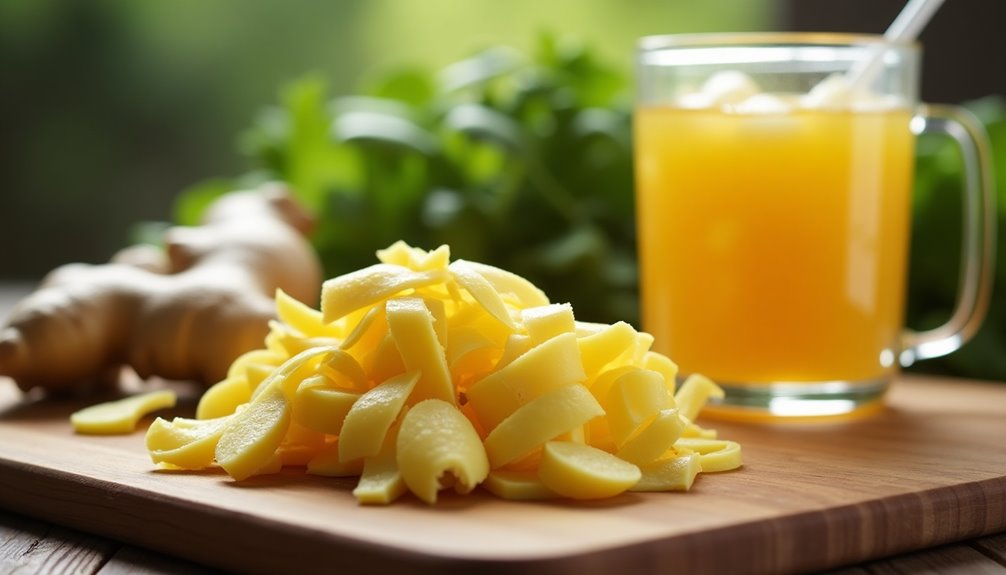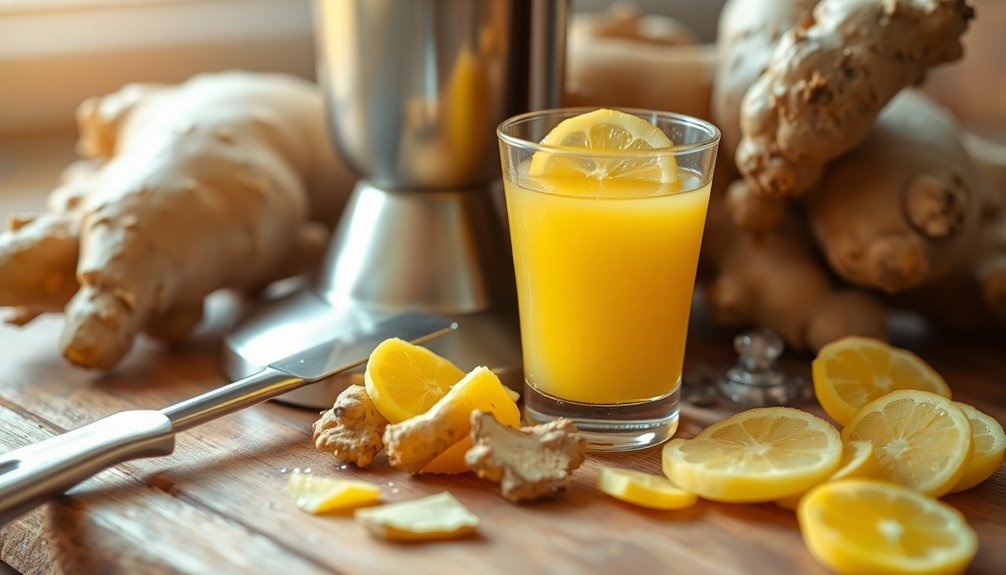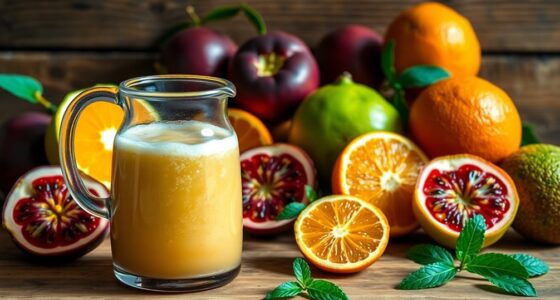To juice ginger, start with fresh ginger root, cutting it into 2-inch chunks. If you have a juicer, simply process the chunks for quick extraction. If not, blend them with filtered water—use 1 cup of water for every ounce of ginger—and strain the mixture through a fine mesh strainer. You can store your ginger juice in the fridge for up to three days or freeze it for longer use. There's so much more you can do with ginger juice!
Key Takeaways
- Use fresh ginger root, cutting it into 2-inch chunks for easier juicing.
- If using non-organic ginger, peel it; organic ginger can be scrubbed clean.
- A juicer is the quickest method for extracting ginger juice.
- If no juicer is available, blend ginger chunks with water, then strain the mixture.
- Store ginger juice in an airtight container in the refrigerator or freeze in ice cube trays.

Juicing ginger can elevate your health game, and it's easier than you might think. Fresh ginger juice is packed with numerous health benefits, from aiding digestion to fighting inflammation. Whether you're looking to boost your immune system or simply add a zesty flavor to your drinks, learning how to juice ginger is a fantastic skill to have in your culinary arsenal.
To get started, you'll need fresh ginger root. If you're using organic ginger, you can skip the peeling step; just scrub it clean under running water to remove any dirt. For non-organic ginger, peeling is recommended. Once you have your ginger ready, you can choose your method of juicing. If you own a juicer, simply cut the ginger into 2-inch chunks and push them through the machine. It's that straightforward! You can expect to yield about ½ to ¾ cup of juice for every pound of ginger you use.
If you don’t have a juicer, don’t worry—you can still make ginger juice! Just chop the ginger into smaller pieces and blend it with filtered water. The ratio here isn’t strict, but a good starting point is about one cup of water for every ounce of chopped ginger. Once you’ve blended it to a smooth consistency, you’ll want to strain the mixture to separate the juice from the pulp. For this, you can use a fine mesh strainer or cheesecloth to strain the blended ginger. Just pour the mixture through the cheesecloth and squeeze out the juice. You’ll be left with a vibrant, homemade ginger juice that’s ready for use. Once you’ve strained the mixture, you can store the homemade ginger juice in an airtight container in the refrigerator for up to a week. This flavorful juice can be used in various drinks, marinades, or even as a health tonic. If you’re curious about how to prepare ginger juice, experimenting with different ratios of ginger to water can help you discover the perfect taste for your preference. If you’re feeling adventurous, you can also enhance your ginger juice by adding other ingredients like lemon, honey, or turmeric for added flavor and health benefits. Once you’ve mastered how to prepare ginger juice, consider using it as a base for sparkling drinks or incorporating it into your favorite recipes for an extra kick. The possibilities are endless, and you’ll likely find that homemade ginger juice quickly becomes a staple in your kitchen.
Storing your fresh ginger juice is easy. You can keep it in an airtight glass container in the refrigerator for up to three days. If you want to preserve it for longer, consider using an ice cube tray. Pour your ginger juice into the compartments of the tray, freeze it, and once solid, transfer the cubes to a freezer-safe bag. This way, you can easily pop out a cube whenever you're in the mood for a health boost!
When it comes to consumption, it's best to take ginger juice in moderation. The recommended dose is around 30ml per day, which is about 2 tablespoons. You can enjoy it straight or mix it into smoothies, teas, or salad dressings for a spicy kick.
Incorporating this homemade ginger juice into your diet can lead to numerous health benefits. So, whether you choose to use a juicer or blend it yourself, making ginger juice is a simple and rewarding process. You'll not only enjoy the freshness of your juice but also the many ways it can enhance your overall well-being. Happy juicing!
Frequently Asked Questions
How to Get the Juice From Ginger?
To get the juice from ginger, you'll want to start by washing the fresh root thoroughly.
Cut it into 1-2 inch pieces. If you have a juicer, just feed the pieces in to extract the juice.
If you're using a blender, blend the ginger with a bit of water, then strain the mixture through a fine mesh sieve.
Store the juice in an airtight container in the fridge for up to a week.
Do You Have to Peel Ginger Before Juicing?
You don't have to peel ginger before juicing if it's organic, since the skin's safe to eat and offers nutrients.
For non-organic ginger, it's best to peel it to avoid pesticide residues.
If you're using organic ginger, just scrub it under running water to clean it.
If you do decide to peel, use the back of a spoon for easy removal and to keep more of the flavorful root intact.
How Much Ginger Is Safe to Juice?
When it comes to juicing ginger, you should stick to about 30ml daily for safety.
Consuming more than 4 grams a day might lead to digestive issues or heartburn. If you're pregnant, check with your healthcare provider first, as high amounts could cause complications.
Also, if you're on blood-thinning medications, limit your intake to avoid interactions.
Start with small amounts and gradually increase to see how your body reacts.
Can I Juice Ginger Without a Juicer?
Yes, you can juice ginger without a juicer! Just chop the ginger, then blend it with water in a high-speed blender.
A good ratio is about 5 ounces of ginger to 1 cup of water. After blending, strain the mixture using a fine mesh strainer or cheesecloth to get the juice out.
You'll maximize your yield by pressing the pulp. Store any leftover juice in an airtight container in the fridge for up to a week!
Conclusion
Juicing ginger is like unlocking a treasure chest of flavor and health benefits. As you press the juicer's button, envision the vibrant golden liquid flowing, symbolizing vitality and warmth. Each drop carries the essence of the root, infusing your drinks with a zesty kick that awakens your senses. So, embrace this potent elixir and let it invigorate your life, reminding you that sometimes, the simplest ingredients hold the most profound power. Cheers to your health!
Cindy thoroughly researches juicing trends, techniques, and recipes to provide readers with practical advice and inspiration. Her writing style is accessible, engaging, and designed to make complex concepts easy to understand. Cindy’s dedication to promoting the advantages of juicing shines through her work, empowering readers to make positive changes in their lives through the simple act of juicing.

















